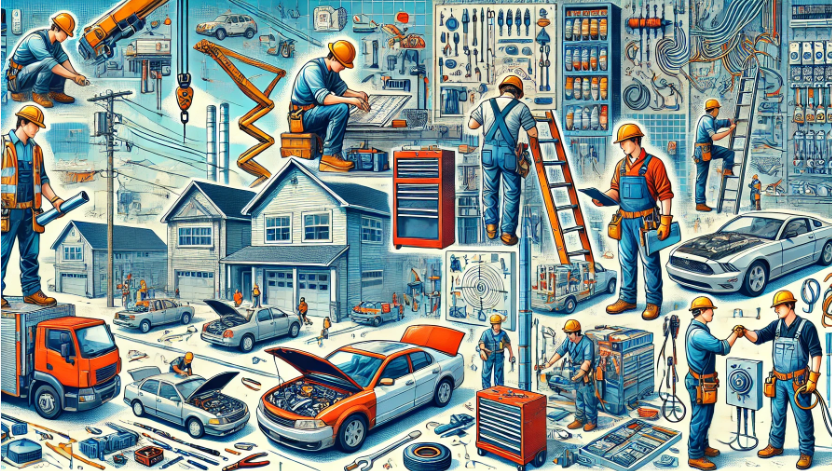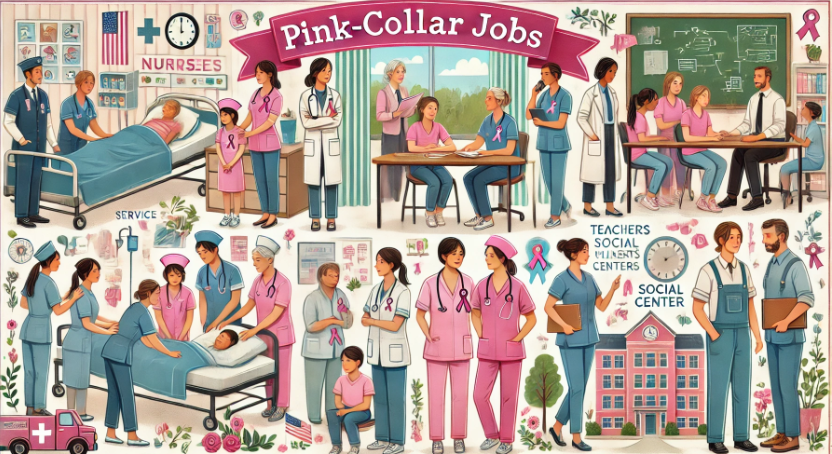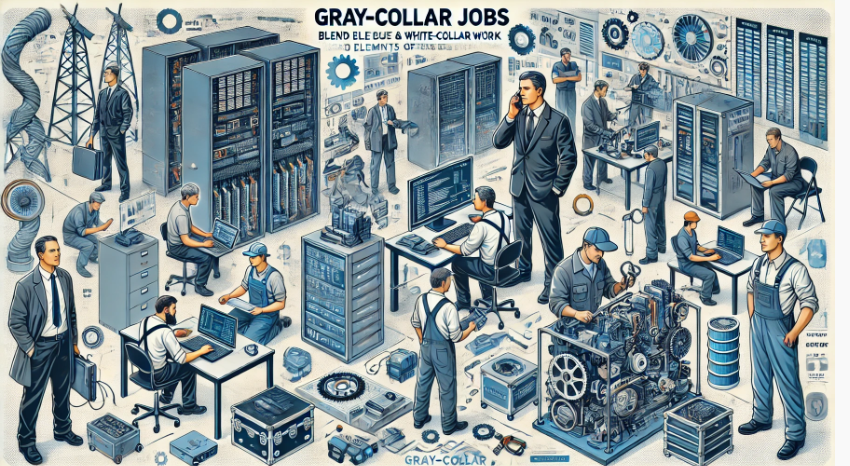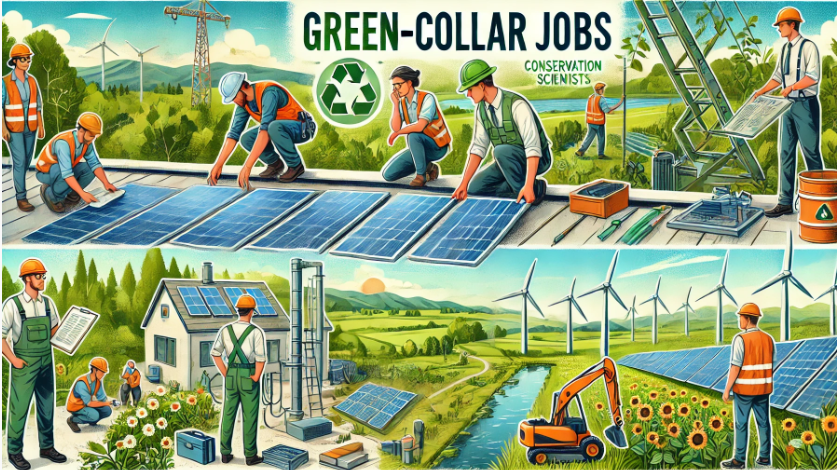Ever wondered why we talk about jobs in terms of colors? It’s not just a fancy way to describe what people do for a living – it’s a whole spectrum of career paths that shape our economy and society. From the hard-hat wearing blue-collar workers to the suit-and-tie white-collar professionals, and the often-overlooked pink-collar service providers, each group plays a crucial role in keeping our world spinning.
In this deep dive into the world of collar jobs, we’re going to peel back the layers and really get to grips with what makes each category tick. We’ll explore the nitty-gritty of blue, white, and pink-collar jobs, and even touch on some emerging categories that are shaking things up. So, whether you’re a student trying to figure out your career path, a professional looking to switch lanes, or just someone curious about the working world, buckle up – we’re about to embark on a colorful journey through the job market!
What You’ll Learn
- The definitions and characteristics of blue, white, and pink-collar jobs
- Historical context and evolution of collar job classifications
- Skills required for each collar category
- Current trends and future outlook for different collar jobs
- Emerging collar categories like gray and green
- The impact of technology and societal shifts on collar jobs
- Gender dynamics in various collar categories
- Education and training pathways for different collar jobs
- Tips for navigating the modern job market across collar categories
Buckle up, folks! By the time you finish this article, you’ll be a bona fide expert on the spectrum of collar jobs. You’ll have the inside scoop on what makes each category unique, the skills you need to succeed, and where these jobs are headed in the future. Whether you’re plotting your career path or just satisfying your curiosity, this knowledge will give you a whole new perspective on the working world. So, let’s roll up our sleeves (whatever color they may be) and dive in!
Key Takeaways
- Collar job categories are more than just colors – they represent distinct skill sets, industries, and career paths.
- Blue-collar jobs focus on manual labor and skilled trades, while white-collar jobs typically involve office work and professional services.
- Pink-collar jobs, often overlooked, play a crucial role in service-oriented industries.
- The lines between collar categories are blurring, with new categories like gray and green collar jobs emerging.
- Technology and automation are reshaping all collar job categories, requiring workers to adapt and upskill.
- Understanding the spectrum of collar jobs can help job seekers make informed career decisions and employers build diverse, skilled teams.
Now that we’ve got a bird’s-eye view of what’s to come, let’s dig into the meat and potatoes of collar jobs!
What Are Collar Jobs?
Definition and Historical Context
Alright, let’s start at square one. What exactly are collar jobs, and why do we use colors to describe them? Well, it’s not because someone went crazy with a box of crayons at the job fair!
The term “collar job” dates back to the early 20th century when the color of a worker’s collar literally indicated their job type. Blue-collar workers, typically in manufacturing or manual labor, wore durable blue denim or chambray shirts that could handle a bit of grease and grime. White-collar workers, on the other hand, sported crisp white shirts suitable for the office environment.
As time went on, these color-coded categories became shorthand for different types of work, skills, and even social status. But here’s the kicker – as our economy has evolved, so has the spectrum of collar jobs. We’re not just talking blue and white anymore, folks!
The Expanding Spectrum
Today, the world of collar jobs is more colorful than ever. Let’s break it down:
- Blue Collar: These are your traditional manual labor and skilled trade jobs. Think construction workers, mechanics, and electricians.
- White Collar: These jobs typically involve office work, management, and professional services. Lawyers, accountants, and executives fall into this category.
- Pink Collar: This category, which we’ll dive into later, includes service-oriented and care-related jobs, often dominated by women historically. Nurses, teachers, and social workers are examples.
- Gray Collar: A newer category that blends elements of blue and white collar work. These jobs often require technical skills and specialized knowledge. Think IT professionals or skilled technicians.
- Green Collar: Another newcomer, focusing on jobs in environmental and sustainability sectors. Solar panel installers and conservation scientists fit the bill here.
The spectrum of collar jobs and their unique roles is constantly evolving, reflecting changes in our economy, technology, and society. It’s like a living, breathing ecosystem of work!
The Spectrum of Collar Jobs
Now that we’ve got the basics down, let’s roll up our sleeves and dig into each category. We’ll start with the OG of collar jobs – blue collar.
Blue Collar Jobs

Definition and Characteristics
Blue-collar jobs are the backbone of our physical world. These are the folks who build our houses, fix our cars, and keep our lights on. Traditionally, blue-collar work involves manual labor and skilled trades. It’s hands-on, often physically demanding, and requires specialized technical skills.
But don’t make the mistake of thinking blue-collar work is all brawn and no brain. Many blue-collar jobs require serious smarts, problem-solving skills, and even creativity. Ever tried to figure out why a car engine is making that weird noise? It’s like solving a mystery with a wrench!
Common Industries and Roles
Blue-collar workers are the unsung heroes in a variety of industries. Here’s a taste:
- Construction: Carpenters, electricians, plumbers, welders
- Manufacturing: Assembly line workers, machine operators, quality control inspectors
- Transportation: Truck drivers, mechanics, air traffic controllers
- Maintenance: Janitors, landscapers, HVAC technicians
- Energy: Oil rig workers, miners, wind turbine technicians
Skills Required
To thrive in blue-collar jobs, you’ll need a mix of hard and soft skills:
- Technical know-how: Each trade has its own set of specialized skills. A plumber needs to understand pipe systems, while an electrician must know their way around a circuit board.
- Physical stamina: Many blue-collar jobs involve heavy lifting, long hours on your feet, or working in challenging conditions.
- Problem-solving: When something breaks, blue-collar workers are the first line of defense. They need to diagnose issues and find creative solutions.
- Attention to detail: Whether you’re building a house or assembling a car, precision is key.
- Safety consciousness: Many blue-collar jobs involve potential hazards, so understanding and following safety protocols is crucial.
- Teamwork: Large projects often require coordination between different trades, making communication and collaboration essential.
Job Outlook and Trends
Now, you might be thinking, “Aren’t robots taking over all these jobs?” Well, not so fast! While it’s true that automation has impacted some blue-collar sectors, many of these jobs are still going strong. In fact, there’s a growing shortage of skilled tradespeople in many areas.
Here are some trends to watch:
- Technological integration: Even traditional trades are getting high-tech. For example, mechanics now need to understand complex computer systems in modern cars.
- Green energy boom: The shift towards renewable energy is creating new blue-collar jobs in solar and wind power industries.
- Infrastructure investment: Many countries are focusing on upgrading their infrastructure, which means more jobs in construction and related fields.
- Skills gap: As older workers retire, there’s a growing need for young people to enter skilled trades, leading to good job prospects and competitive wages.
- Emphasis on safety: With stricter regulations and a focus on worker well-being, there’s an increased demand for safety specialists and a need for all workers to be safety-conscious.
So, if you’re considering a blue-collar career, don’t let anyone tell you it’s a dead end. These jobs are evolving, not disappearing, and they offer plenty of opportunities for those willing to get their hands dirty (literally and figuratively)!
White Collar Jobs

Definition and Characteristics
When you picture a white-collar job, you might think of suit-clad executives in high-rise offices. But hold your horses – there’s more to it than that! White-collar jobs typically involve office work, management, and professional services. They’re the kind of gigs where your main tools are your brain, a computer, and maybe a really fancy pen.
These jobs usually require formal education and specialized knowledge. They’re less about physical labor and more about mental heavy lifting. Think number-crunching, problem-solving, and enough meetings to make your calendar look like a game of Tetris.
Common Industries and Roles
White-collar workers are spread across various industries. Here’s a sampler platter:
- Finance: Accountants, financial analysts, investment bankers
- Healthcare: Doctors, pharmacists, hospital administrators
- Legal: Lawyers, paralegals, judges
- Technology: Software developers, data scientists, IT managers
- Education: Teachers, professors, education administrators
- Business: Marketing managers, HR specialists, CEOs
Skills Required
To rock a white-collar job, you’ll need to sharpen these skills:
- Analytical thinking: Many white-collar jobs involve analyzing data, solving complex problems, or making strategic decisions.
- Communication: Whether you’re presenting to clients or writing reports, clear communication is key.
- Tech-savviness: Most white-collar jobs require proficiency with various software and digital tools.
- Leadership: As you climb the corporate ladder, you’ll need to guide and motivate teams.
- Adaptability: In rapidly changing industries, the ability to learn and adapt is crucial.
- Time management: Juggling multiple projects and deadlines is par for the course.
Job Outlook and Trends
White-collar jobs are evolving faster than you can say “disruptive innovation.” Here’s what’s cooking:
- Remote work revolution: The pandemic kicked this trend into high gear, and it’s here to stay.
- AI and automation: While some tasks are being automated, new roles are emerging that focus on managing and interpreting AI outputs.
- Emphasis on soft skills: As machines take over more routine tasks, uniquely human skills like creativity and emotional intelligence are becoming more valuable.
- Gig economy growth: More professionals are opting for freelance or contract work, creating a more flexible white-collar landscape.
- Continuous learning: With rapid technological changes, ongoing education and upskilling are becoming necessities, not luxuries.
Pink Collar Jobs

Definition and Characteristics
Alright, let’s talk about the often-overlooked middle child of the collar job family – pink collar jobs. These roles typically involve caregiving, customer service, and support functions. They’re the jobs that keep our society running smoothly, often behind the scenes.
The term “pink collar” emerged in the 1970s to describe jobs traditionally held by women. But don’t let the name fool you – these jobs aren’t just for the ladies, and they’re far from being lightweight or less important.
Common Industries and Roles
Pink collar workers are the unsung heroes in many sectors:
- Healthcare: Nurses, medical assistants, home health aides
- Education: Preschool and elementary school teachers, teaching assistants
- Hospitality: Waitstaff, hotel receptionists, flight attendants
- Social services: Social workers, counselors, childcare workers
- Administrative support: Secretaries, receptionists, office clerks
- Retail: Sales associates, cashiers, customer service representatives
Skills Required
To thrive in pink collar jobs, you’ll need a unique blend of skills:
- Empathy and emotional intelligence: Many pink collar jobs involve working closely with people, often in sensitive situations.
- Communication: Clear, patient communication is crucial, whether you’re explaining a medical procedure or helping a frustrated customer.
- Multitasking: Pink collar workers often juggle multiple responsibilities simultaneously.
- Adaptability: Every day can bring new challenges, so flexibility is key.
- Attention to detail: Whether it’s administering medication or managing schedules, precision matters.
- Physical stamina: Many of these jobs involve long hours on your feet or other physical demands.
Job Outlook and Trends
Pink collar jobs are experiencing some interesting shifts:
- Growing demand: As our population ages and childcare needs increase, many pink collar jobs are seeing steady growth.
- Increasing recognition: There’s a growing acknowledgment of the essential nature of many pink collar jobs, especially in light of recent global events.
- Technology integration: Even traditionally hands-on jobs are incorporating more technology, from electronic health records to AI-powered customer service tools.
- Push for better compensation: There’s an ongoing discussion about ensuring fair pay for these often undervalued roles.
- Changing gender dynamics: More men are entering traditionally female-dominated fields, slowly shifting the gender balance.
As we delve into this job category, it’s essential to understand the specific roles and opportunities offered in pink-collar jobs. For a comprehensive look at these career paths, check out our article on Exploring Pink-Collar Jobs: Careers, Opportunities, and Growth.
Gray Collar Jobs

Introduction to Gray Collar Jobs
Now, let’s talk about the new kid on the block – gray collar jobs. These roles are like the cool fusion restaurants of the job world, blending elements of blue and white collar work. They often require technical skills, specialized knowledge, and sometimes a dash of manual labor.
The term “gray collar” emerged as traditional job categories started to blur. These jobs often require more education than typical blue-collar work, but they’re more hands-on than your average white-collar gig.
Examples of Gray Collar Roles
Gray collar workers are the chameleons of the job market. You’ll find them in various fields:
- Healthcare: Radiologic technologists, dental hygienists, paramedics
- Technology: IT support specialists, network administrators, cybersecurity analysts
- Engineering: Technicians in various fields (aerospace, electrical, environmental)
- Culinary arts: Chefs, sommeliers, food scientists
- Media: Film and TV production crews, sound engineers, graphic designers
Skills and Job Outlook
To rock a gray collar job, you’ll need a unique skill set:
- Technical expertise: These jobs often require specialized knowledge in specific areas.
- Problem-solving: Many gray collar jobs involve troubleshooting and finding creative solutions.
- Adaptability: With technology constantly evolving, the ability to learn new skills is crucial.
- Communication: Gray collar workers often need to explain complex concepts to non-experts.
- Physical skills: Some gray collar jobs involve a mix of mental and physical tasks.
The outlook for gray collar jobs is pretty rosy. As technology advances and industries evolve, these hybrid roles are becoming increasingly important. Many gray collar jobs offer solid salaries and job security, making them attractive options for those looking to blend technical skills with hands-on work.
Green Collar Jobs

Definition of Green Collar Jobs
Let’s paint the town green! Green collar jobs are the new kids on the block, and they’re all about saving the planet while earning a paycheck. These roles focus on environmental sustainability, conservation, and renewable energy. It’s like being Captain Planet, but with a regular salary and probably fewer cartoon villains to fight.
Green collar jobs span a wide range of industries and skill levels. They can involve anything from installing solar panels to developing new eco-friendly technologies. The common thread? They all contribute to a more sustainable future.
Examples of Industries
Green collar workers are sprouting up everywhere:
- Renewable Energy: Solar panel installers, wind turbine technicians, biofuel production managers
- Conservation: Wildlife biologists, forest rangers, environmental scientists
- Sustainable Agriculture: Organic farmers, agricultural consultants, urban gardeners
- Green Construction: LEED-certified architects, energy efficiency auditors, green building consultants
- Waste Management: Recycling coordinators, hazardous waste technicians, composting specialists
- Clean Transportation: Electric vehicle designers, bicycle mechanics, public transit planners
Skills Required and Job Outlook
To flourish in a green collar job, you’ll need to cultivate these skills:
- Environmental awareness: Understanding ecological issues and sustainability principles is a must.
- Technical know-how: Many green jobs require specialized skills, whether it’s operating renewable energy systems or conducting environmental assessments.
- Adaptability: The green sector is evolving rapidly, so you’ll need to be ready to learn and grow.
- Problem-solving: Finding innovative solutions to environmental challenges is often part of the job description.
- Communication: You might need to explain complex environmental concepts to the public or stakeholders.
The future’s looking bright (and green) for these jobs. With growing concern about climate change and increasing investment in sustainable technologies, green collar jobs are expected to grow faster than average. It’s not just a trend – it’s a seismic shift in how we think about work and its impact on our planet.
The Evolution of Collar Jobs
Historical Changes
Alright, history buffs, let’s take a trip down memory lane! The concept of collar jobs has come a long way since it first popped up in the early 20th century.
In the beginning, it was pretty simple:
- Blue collar: Factory workers, manual laborers
- White collar: Office workers, managers
But as our economy changed, so did our jobs. The rise of the service sector in the mid-20th century led to the recognition of pink collar jobs. And as technology advanced, we started seeing new categories like gray and green collar jobs emerge.
It’s like watching a black and white TV slowly turn into a 4K ultra HD model – the picture’s getting more complex and colorful all the time!
Influence of Technology and Automation
Now, let’s talk about the elephant in the room – or should I say, the robot? Technology and automation have shaken up the job market like a snow globe.
For blue collar jobs:
- Some roles have been automated, but new ones have emerged.
- Many traditional trades now require tech skills. (Ever seen a mechanic without a diagnostic computer these days?)
In the white collar world:
- Routine tasks are increasingly automated.
- There’s a growing emphasis on skills that AI can’t easily replicate, like creativity and emotional intelligence.
Pink collar jobs aren’t immune either:
- Technology is changing how care is delivered (telemedicine, anyone?).
- Customer service is being transformed by chatbots and AI.
It’s not all doom and gloom, though. While some jobs are disappearing, new ones are popping up faster than you can say “artificial intelligence.”
Societal Shifts
Society’s values and needs have also played a big role in reshaping collar jobs:
- Education: As college became more accessible, we saw a surge in white collar jobs.
- Gender equality: More women entered the workforce, challenging traditional job categories.
- Work-life balance: There’s a growing demand for flexible work arrangements across all collar categories.
- Environmental awareness: This has fueled the growth of green collar jobs.
- Gig economy: The rise of freelance and contract work is blurring the lines between traditional job categories.
The takeaway? The spectrum of collar jobs and their unique roles isn’t set in stone. It’s more like a living, breathing organism that adapts to our changing world. So, whether you’re blue, white, pink, gray, or green collar, remember – change is the only constant in the world of work!
Gender Dynamics in Collar Jobs
Historical Gender Roles
Let’s face it, folks – the world of work used to be more gendered than a 1950s toy catalog. Traditionally, blue collar jobs were seen as “men’s work,” while pink collar jobs were “women’s work.” White collar jobs? Well, the higher up you went, the more likely you were to see a sea of men in suits.
But here’s the kicker – these divisions weren’t just about personal preference. They were often reinforced by societal expectations, hiring practices, and even laws. It was like someone drew a line in the sand and said, “Guys on this side, gals on that side.”
Current Trends in Gender Representation
Now, before you start thinking we’re stuck in a time warp, let’s look at how things have changed:
- Blue collar jobs: More women are entering traditionally male-dominated fields like construction and manufacturing. It’s not uncommon to see female welders or electricians these days.
- White collar jobs: Women have made significant strides in professional and managerial roles. In fact, in some countries, women now outnumber men in fields like law and medicine.
- Pink collar jobs: While still female-dominated, we’re seeing more men in roles like nursing and elementary education. It’s about time we realized that compassion isn’t a gendered trait!
- Gray and green collar jobs: These newer categories tend to have a more balanced gender representation from the get-go.
But let’s not break out the “mission accomplished” banner just yet. We’ve still got work to do:
- The gender pay gap persists across all collar categories.
- Women are still underrepresented in top leadership positions in many industries.
- Some fields remain heavily gendered (like construction for men and childcare for women).
Efforts and Campaigns for Diversity
So, what’s being done to level the playing field? Quite a bit, actually:
- Education initiatives: Programs encouraging girls to pursue STEM fields and boys to consider caring professions.
- Corporate diversity programs: Many companies are setting targets for gender diversity and implementing policies to support it.
- Mentorship and networking: Organizations are creating opportunities for underrepresented groups to connect and support each other.
- Policy changes: Governments are implementing laws against discrimination and promoting equal pay.
- Changing narratives: Media representation is slowly shifting, showing people of all genders in diverse career roles.
Remember, folks – diversity isn’t just about fairness (although that’s important!). It’s about bringing different perspectives to the table and making our workforce stronger and more innovative. After all, if we’re going to solve the world’s problems, we need all hands on deck – regardless of what color collar they’re wearing!
Skill Sets and Education Requirements
Education Paths for Different Collar Job Categories
Alright, let’s talk about hitting the books (or the workshop, or the internship…). The path to your dream job can be as varied as the jobs themselves:
- Blue Collar:
• Often requires vocational training or apprenticeships
• Some roles may need certifications or licenses
• Example: An electrician might complete a 4-year apprenticeship program - White Collar:
• Typically requires a college degree
• Some positions need advanced degrees (law, medicine, etc.)
• Example: An accountant usually needs a bachelor’s degree in accounting or finance - Pink Collar:
• Requirements vary widely
• Can range from on-the-job training to advanced degrees
• Example: A registered nurse needs a nursing degree and license, while a retail salesperson might receive on-the-job training - Gray Collar:
• Often combines elements of vocational training and formal education
• Many require specific certifications
• Example: An IT technician might have a mix of certifications and a college degree - Green Collar:
• Can range from vocational training to advanced degrees, depending on the role
• Often requires specialized knowledge in environmental science or sustainable technologies
• Example: A solar panel installer might need vocational training, while an environmental engineer would typically need a bachelor’s degree or higher
Importance of Vocational Training and Skill Development
Here’s a truth bomb for you: a traditional four-year college degree isn’t the only ticket to success. Vocational training and skill development are becoming increasingly important across all collar categories. Why? Well:
- Rapid technological changes: Many jobs require continual upskilling to keep pace with new tech.
- Skills gap: There’s a growing demand for specialized skills that aren’t always taught in traditional academic settings.
- Practical experience: Vocational training often provides hands-on experience that employers value.
- Career changers: As people switch careers more frequently, shorter, focused training programs are becoming popular.
So whether you’re learning to code, weld, or perform open-heart surgery, remember – in today’s job market, it’s all about the skills you bring to the table.
Skills-Based Hiring Trends
Speaking of skills, there’s a new sheriff in town when it comes to hiring: skills-based recruitment. More and more employers are focusing on what you can do rather than where you learned to do it.
This trend is shaking things up across all collar categories:
- Blue Collar: Employers are looking for specific technical skills and certifications.
- White Collar: There’s growing emphasis on soft skills like critical thinking and adaptability.
- Pink Collar: Interpersonal skills and specific caregiving abilities are taking center stage.
- Gray Collar: Technical expertise combined with problem-solving skills is the golden ticket.
- Green Collar: Knowledge of sustainable practices paired with relevant technical skills is key.
The bottom line? Whether you’re wearing a hard hat or a stethoscope, it’s your skills that’ll get you hired and help you thrive. So keep learning, stay curious, and never stop growing. In the colorful world of collar jobs, being a lifelong learner is always in style!
Future of Collar Jobs
Predictions and Trends for Each Collar Job Category
Let’s dust off our crystal ball and take a peek into the future of collar jobs. Spoiler alert: it’s looking pretty exciting!
Blue Collar:
- Increased integration of technology (think: augmented reality for maintenance work)
- Growing demand for green construction and sustainable manufacturing skills
- Potential shortage of skilled tradespeople as older workers retire
White Collar:
- Rise of remote and hybrid work models
- Increasing importance of data analysis and digital literacy across industries
- Growing emphasis on soft skills like creativity and emotional intelligence
Pink Collar:
- Expansion of telehealth and remote caregiving options
- Increased use of AI and robotics in customer service roles
- Growing demand for eldercare services as populations age
Gray Collar:
- Continued growth in tech-related roles
- Increasing overlap with green collar jobs, especially in areas like sustainable tech
- More emphasis on continuous learning to keep up with technological advancements
Green Collar:
- Exponential growth as countries invest in renewable energy and sustainable practices
- Emergence of new roles related to climate change mitigation and adaptation
- Integration of green practices into traditional blue and white collar jobs
Impact of Remote Work and Digitalization
Hold onto your home office chairs, folks, because remote work and digitalization are revolutionizing the collar job landscape!
- Blurring geographical boundaries: Your coworker might be in the next town or on the next continent.
- Changing skill requirements: Digital literacy is becoming as essential as reading and writing.
- New collar categories emerging: “Digital collar” jobs, anyone?
- Reshaping office culture: Water cooler chats are being replaced by Slack channels and virtual happy hours.
- Impacting urban planning: With more people working from home, we might see shifts in where people choose to live and how cities are designed.
But it’s not all smooth sailing. Remote work brings its own challenges:
- Maintaining work-life balance when your home is your office
- Ensuring equal opportunities for remote and in-person workers
- Addressing the digital divide to ensure all workers can participate in the digital economy
Importance of Adaptability and Continuous Learning
If there’s one thing you take away from this article, let it be this: in the future job market, adaptability is your superpower, and continuous learning is your secret weapon.
Why? Well:
- Rapid technological changes: What’s cutting-edge today might be obsolete tomorrow.
- Shifting job markets: New industries are emerging while others are fading away.
- Changing societal needs: As our world evolves, so do the skills and jobs we need.
- Longer working lives: With people working well into their 60s and 70s, we need to stay relevant for longer.
So, how can you stay ahead of the curve?
- Embrace lifelong learning: Take online courses, attend workshops, read widely.
- Develop transferable skills: Focus on abilities that are valuable across industries.
- Stay curious: Keep an eye on emerging trends in your field and beyond.
- Be open to change: The ability to pivot and adapt is invaluable.
Remember, folks, the future of work isn’t about the color of your collar – it’s about your willingness to learn, adapt, and grow. Whether you’re blue, white, pink, gray, or green collar, the most important “collar” you can wear is one of flexibility and continuous improvement.
In this ever-changing landscape of collar jobs and their unique roles, the most successful workers will be those who can navigate the entire spectrum, picking up new skills and adapting to new challenges along the way. So, are you ready to color outside the lines of traditional job categories and create your own vibrant career path?
Conclusion
Whew! We’ve taken quite the journey through the colorful world of collar jobs, haven’t we? From the hands-on grit of blue collar work to the office hustle of white collar jobs, the caring touch of pink collar roles, the tech-savvy world of gray collar positions, and the planet-saving mission of green collar jobs – we’ve covered it all.
Here’s the big picture: the spectrum of collar jobs and their unique roles is more diverse and dynamic than ever before. The lines between these categories are blurring, new shades are emerging, and the whole palette is constantly shifting with technological advancements and societal changes.
Key takeaways to remember:
- Every collar category plays a vital role in our economy and society.
- The future of work is all about adaptability and continuous learning.
- Technology is reshaping all collar categories, creating new opportunities and challenges.
- Gender dynamics in the workplace are evolving, but there’s still work to be done.
- Skills-based hiring is becoming increasingly important across all collar categories.
So, whether you’re just starting your career journey or looking to make a change, remember this: your success isn’t determined by the color of your collar, but by your willingness to learn, adapt, and bring your unique skills to the table.
The future of work is colorful, diverse, and full of opportunity. It’s not about fitting into a predefined category, but about creating your own unique blend of skills and experiences. So go ahead, mix those colors, and paint your own career masterpiece!
Frequently Asked Questions (FAQ)
1. Q: What is the difference between blue, white, and pink collar jobs?
A: Blue collar jobs typically involve manual labor and skilled trades, often in industries like construction or manufacturing. White collar jobs are usually office-based and involve professional, managerial, or administrative work. Pink collar jobs are service-oriented roles, often in industries like healthcare, education, and customer service.
2. Q: How has the economic landscape changed for collar jobs in recent years?
A: The landscape has shifted dramatically due to factors like technological advancements, globalization, and changing societal needs. We’ve seen the emergence of new categories like gray and green collar jobs, an increase in remote work opportunities, and a growing emphasis on digital skills across all collar categories.
3. Q: What skills are in demand across different collar job categories?
A: While specific technical skills vary by field, some universally in-demand skills include:
• Adaptability and willingness to learn
• Digital literacy
• Problem-solving and critical thinking
• Communication and interpersonal skills
• Creativity and innovation
4. Q: How can job seekers prepare for a career in any collar job category?
A: Job seekers can prepare by:
- Staying informed about industry trends and emerging technologies in their field of interest
- Investing in continuous learning through courses, workshops, or certifications
- Developing a mix of technical and soft skills
- Being open to different types of work arrangements (remote, freelance, etc.)
- Building a professional network across various industries
- Cultivating adaptability and resilience to navigate changes in the job market
5. Q: Are traditional collar job categories becoming less relevant in today’s job market?
A: While traditional categories still exist, the lines between them are blurring. Many jobs now combine elements from different collar categories, and new categories like gray and green collar jobs have emerged. The focus is shifting more towards specific skill sets rather than rigid job categories.
6. Q: How is technology impacting collar jobs across different categories?
A: Technology is reshaping all collar categories. In blue collar jobs, we’re seeing increased use of automation and smart technologies. White collar jobs are being transformed by AI and data analytics. Pink collar jobs are incorporating telehealth and digital customer service tools. Overall, digital literacy is becoming crucial across all categories.
Remember, in today’s rapidly evolving job market, the most valuable skill you can have is the ability to learn and adapt. So keep exploring, keep learning, and don’t be afraid to color outside the lines of traditional job categories!











